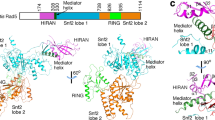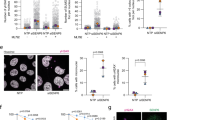Abstract
Rad60 family members contain functionally enigmatic, integral SUMO-like domains (SLDs). We show here that despite their divergence from SUMO, each Rad60 SLD interacts with a subset of SUMO pathway enzymes: SLD2 specifically binds the SUMO E2 conjugating enzyme (Ubc9), whereas SLD1 binds the SUMO E1 (Fub2, also called Uba2) activating and E3 (Pli1, also called Siz1 and Siz2) specificity enzymes. The molecular basis of this selectivity is revealed by our 0.97-Å resolution crystal structure of Rad60 SLD2, which shows that apart from the conserved non-substrate SUMO:Ubc9 interface, the surface features of SLD2 are distinct from those of SUMO. Abrogation of the SLD2:Ubc9 FEG motif–dependent interaction results in hypersensitivity to genotoxic stress and an increase in spontaneous recombination associated with aberrant replication forks. Our results provide a mechanistic basis for the near-synonymous roles of Rad60 and SUMO in survival of genotoxic stress and suggest unprecedented DNA-damage-response functions for SLDs in regulating sumoylation.
This is a preview of subscription content, access via your institution
Access options
Subscribe to this journal
Receive 12 print issues and online access
$189.00 per year
only $15.75 per issue
Buy this article
- Purchase on Springer Link
- Instant access to full article PDF
Prices may be subject to local taxes which are calculated during checkout





Similar content being viewed by others
References
Friedberg, E.C. et al. DNA Repair and Mutagenesis (American Society for Microbiology Press, Washington, DC, 2006).
Lambert, S. & Carr, A.M. Checkpoint responses to replication fork barriers. Biochimie 87, 591–602 (2005).
Tourriere, H. & Pasero, P. Maintenance of fork integrity at damaged DNA and natural pause sites. DNA Repair (Amst.) 6, 900–913 (2007).
Branzei, D. & Foiani, M. Regulation of DNA repair throughout the cell cycle. Nat. Rev. Mol. Cell Biol. 9, 297–308 (2008).
Branzei, D. et al. Ubc9- and mms21-mediated sumoylation counteracts recombinogenic events at damaged replication forks. Cell 127, 509–522 (2006).
Ulrich, H.D. Mutual interactions between the SUMO and ubiquitin systems: a plea of no contest. Trends Cell Biol. 15, 525–532 (2005).
Kerscher, O., Felberbaum, R. & Hochstrasser, M. Modification of proteins by ubiquitin and ubiquitin-like proteins. Annu. Rev. Cell Dev. Biol. 22, 159–180 (2006).
Hartmann-Petersen, R. & Gordon, C. Integral UBL domain proteins: a family of proteasome interacting proteins. Semin. Cell Dev. Biol. 15, 247–259 (2004).
Boddy, M.N. et al. Replication checkpoint kinase Cds1 regulates recombinational repair protein Rad60. Mol. Cell. Biol. 23, 5939–5946 (2003).
Morishita, T., Tsutsui, Y., Iwasaki, H. & Shinagawa, H. The Schizosaccharomyces pombe rad60 gene is essential for repairing double-strand DNA breaks spontaneously occurring during replication and induced by DNA-damaging agents. Mol. Cell. Biol. 22, 3537–3548 (2002).
Raffa, G.D., Wohlschlegel, J., Yates, J.R. III & Boddy, M.N. SUMO-binding motifs mediate the Rad60-dependent response to replicative stress and self-association. J. Biol. Chem. 281, 27973–27981 (2006).
Andrews, E.A. et al. Nse2, a component of the Smc5–6 complex, is a SUMO ligase required for the response to DNA damage. Mol. Cell. Biol. 25, 185–196 (2005).
Miyabe, I., Morishita, T., Hishida, T., Yonei, S. & Shinagawa, H. Rhp51-dependent recombination intermediates that do not generate checkpoint signal are accumulated in Schizosaccharomyces pombe rad60 and smc5/6 mutants after release from replication arrest. Mol. Cell. Biol. 26, 343–353 (2006).
Pebernard, S., Wohlschlegel, J., McDonald, W.H., Yates, J.R. III & Boddy, M.N. The Nse5-Nse6 dimer mediates DNA repair roles of the Smc5-Smc6 complex. Mol. Cell. Biol. 26, 1617–1630 (2006).
Novatchkova, M., Bachmair, A., Eisenhaber, B. & Eisenhaber, F. Proteins with two SUMO-like domains in chromatin-associated complexes: the RENi (Rad60-Esc2–NIP45) family. BMC Bioinformatics 6, 22 (2005).
Dhillon, N. & Kamakaka, R.T. A histone variant, Htz1p, and a Sir1p-like protein, Esc2p, mediate silencing at HMR. Mol. Cell 6, 769–780 (2000).
Cuperus, G. & Shore, D. Restoration of silencing in Saccharomyces cerevisiae by tethering of a novel Sir2-interacting protein, Esc8. Genetics 162, 633–645 (2002).
Ohya, T., Arai, H., Kubota, Y., Shinagawa, H. & Hishida, T. A SUMO-like domain protein, Esc2, is required for genome integrity and sister chromatid cohesion in Saccharomyces cerevisiae. Genetics 180, 41–50 (2008).
Hodge, M.R. et al. NF-AT-driven interleukin-4 transcription potentiated by NIP45. Science 274, 1903–1905 (1996).
Mowen, K.A., Schurter, B.T., Fathman, J.W., David, M. & Glimcher, L.H. Arginine methylation of NIP45 modulates cytokine gene expression in effector T lymphocytes. Mol. Cell 15, 559–571 (2004).
Prudden, J. et al. SUMO-targeted ubiquitin ligases in genome stability. EMBO J. 26, 4089–4101 (2007).
Knipscheer, P., van Dijk, W.J., Olsen, J.V., Mann, M. & Sixma, T.K. Noncovalent interaction between Ubc9 and SUMO promotes SUMO chain formation. EMBO J. 26, 2797–2807 (2007).
Capili, A.D. & Lima, C.D. Structure and analysis of a complex between SUMO and Ubc9 illustrates features of a conserved E2-Ubl interaction. J. Mol. Biol. 369, 608–618 (2007).
Duda, D.M. et al. Structure of a SUMO-binding-motif mimic bound to Smt3p-Ubc9p: conservation of a non-covalent ubiquitin-like protein-E2 complex as a platform for selective interactions within a SUMO pathway. J. Mol. Biol. 369, 619–630 (2007).
Tatham, M.H. et al. Role of an N-terminal site of Ubc9 in SUMO-1, -2, and -3 binding and conjugation. Biochemistry 42, 9959–9969 (2003).
Holm, L. & Sander, C. Touring protein fold space with Dali/FSSP. Nucleic Acids Res. 26, 316–319 (1998).
Lois, L.M. & Lima, C.D. Structures of the SUMO E1 provide mechanistic insights into SUMO activation and E2 recruitment to E1. EMBO J. 24, 439–451 (2005).
Kerscher, O. SUMO junction—what's your function? New insights through SUMO-interacting motifs. EMBO Rep. 8, 550–555 (2007).
Sharma, S., Doherty, K.M. & Brosh, R.M. Jr. Mechanisms of RecQ helicases in pathways of DNA metabolism and maintenance of genomic stability. Biochem. J. 398, 319–337 (2006).
Boddy, M.N. et al. Mus81-Eme1 are essential components of a Holliday junction resolvase. Cell 107, 537–548 (2001).
Boddy, M.N. et al. Damage tolerance protein Mus81 associates with the FHA1 domain of checkpoint kinase Cds1. Mol. Cell. Biol. 20, 8758–8766 (2000).
Doe, C.L., Ahn, J.S., Dixon, J. & Whitby, M.C. Mus81-Eme1 and Rqh1 involvement in processing stalled and collapsed replication forks. J. Biol. Chem. 277, 32753–32759 (2002).
Roseaulin, L. et al. Mus81 is essential for sister chromatid recombination at broken replication forks. EMBO J. 27, 1378–1387 (2008).
Xhemalce, B. et al. Role of SUMO in the dynamics of telomere maintenance in fission yeast. Proc. Natl. Acad. Sci. USA 104, 893–898 (2007).
Xhemalce, B., Seeler, J.S., Thon, G., Dejean, A. & Arcangioli, B. Role of the fission yeast SUMO E3 ligase Pli1p in centromere and telomere maintenance. EMBO J. 23, 3844–3853 (2004).
Perry, J.J., Tainer, J.A. & Boddy, M.N. A SIM-ultaneous role for SUMO and ubiquitin. Trends Biochem. Sci. 33, 201–208 (2008).
Bylebyl, G.R., Belichenko, I. & Johnson, E.S. The SUMO isopeptidase Ulp2 prevents accumulation of SUMO chains in yeast. J. Biol. Chem. 278, 44113–44120 (2003).
Kosoy, A., Calonge, T.M., Outwin, E.A. & O'Connell, M.J. Fission yeast Rnf4 homologs are required for DNA repair. J. Biol. Chem. 282, 20388–20394 (2007).
Chang, Y.G. et al. Different roles for two ubiquitin-like domains of ISG15 in protein modification. J. Biol. Chem. 283, 13370–13377 (2008).
Meulmeester, E., Kunze, M., Hsiao, H.H., Urlaub, H. & Melchior, F. Mechanism and consequences for paralog-specific sumoylation of ubiquitin-specific protease 25. Mol. Cell 30, 610–619 (2008).
Zhu, J. et al. Small ubiquitin-related modifier (SUMO) binding determines substrate recognition and paralog-selective SUMO modification. J. Biol. Chem. 283, 29405–29415 (2008).
Fallon, L. et al. A regulated interaction with the UIM protein Eps15 implicates parkin in EGF receptor trafficking and PI(3)K-Akt signalling. Nat. Cell Biol. 8, 834–842 (2006).
Hoeller, D. et al. E3-independent monoubiquitination of ubiquitin-binding proteins. Mol. Cell 26, 891–898 (2007).
Moreno, S., Klar, A. & Nurse, P. Molecular genetic analysis of fission yeast Schizosaccharomyces pombe. Methods Enzymol. 194, 795–823 (1991).
Bahler, J. et al. Heterologous modules for efficient and versatile PCR-based gene targetting in Schizosaccharomyces pombe. Yeast 14, 943–951 (1998).
Luft, J.R. et al. A deliberate approach to screening for initial crystallization conditions of biological macromolecules. J. Struct. Biol. 142, 170–179 (2003).
Otwinowski, Z. & Minor, W. Processing of X-ray diffraction data collected in oscillation mode. in Macromolecular Crystallography. Vol. 276 (eds. Sweet, R.M. & Carter, C.W., Jr.) 307–326 (Quid Ltd., Hove, UK, 1997).
McCoy, A.J. et al. Phaser crystallographic software. J. Appl. Cryst. 40, 658–674 (2007).
McRee, D.E. XtalView/Xfit—a versatile program for manipulating atomic coordinates and electron density. J. Struct. Biol. 125, 156–165 (1999).
Sheldrick, G.M. A short history of SHELX. Acta Crystallogr. A 64, 112–122 (2008).
Davis, I.W. et al. MolProbity: all-atom contacts and structure validation for proteins and nucleic acids. Nucleic Acids Res. 35, W375–W383 (2007).
Laskowski, R.A., MacArthur, M.W., Moss, D.S. & Thornton, J.M. PROCHECK: a program to check the stereochemical quality of protein structures. J. Appl. Cryst. 26, 283–291 (1993).
Bruns, C.M., Hubatsch, I., Ridderstrom, M., Mannervik, B. & Tainer, J.A. Human glutathione transferase A4–4 crystal structures and mutagenesis reveal the basis of high catalytic efficiency with toxic lipid peroxidation products. J. Mol. Biol. 288, 427–439 (1999).
Acknowledgements
We thank B. Arcangioli (Institut Pasteur, Paris), P. Russell (TSRI, La Jolla, California, USA), S. Pebernard (TSRI) and G. Raffa (Università di Roma La Sapienza, Rome) for generously providing fission yeast strains and additional reagents and The Scripps Cell Cycle Group for support and encouragement. This study was funded in part by US National Institutes of Health grants GM068608 and GM081840 awarded to M.N.B. and CA104660 to J.A.T.
Author information
Authors and Affiliations
Contributions
J.P. conducted the yeast genetics studies, yeast in vivo analyses and in vitro pulldowns and aided protein purification and crystallization experiments. J.J.P.P. conducted protein purification, crystallization, data collection and structural refinement studies and assisted in manuscript preparation. A.S.A. successfully developed and used a high-throughput molecular replacement method for providing phasing data for Rad60 SLD2. J.A.T. and M.N.B. assisted in experimental design and manuscript preparation.
Corresponding authors
Supplementary information
Supplementary Text and Figures
Supplementary Figures 1–5 and Supplementary Table 1 (PDF 14274 kb)
Rights and permissions
About this article
Cite this article
Prudden, J., Perry, J., Arvai, A. et al. Molecular mimicry of SUMO promotes DNA repair. Nat Struct Mol Biol 16, 509–516 (2009). https://doi.org/10.1038/nsmb.1582
Received:
Accepted:
Published:
Issue Date:
DOI: https://doi.org/10.1038/nsmb.1582
This article is cited by
-
Protein divergence in Helicoverpa armigera hemolymph induced by the dietary triflumuron alone and in binary combination with β-sitosterol
International Journal of Tropical Insect Science (2024)
-
Heterochromatic breaks move to the nuclear periphery to continue recombinational repair
Nature Cell Biology (2015)
-
SUMO Rules: Regulatory Concepts and Their Implication in Neurologic Functions
NeuroMolecular Medicine (2013)
-
SUMO modification of the neuroprotective protein TDP1 facilitates chromosomal single-strand break repair
Nature Communications (2012)
-
The SUMO pathway: emerging mechanisms that shape specificity, conjugation and recognition
Nature Reviews Molecular Cell Biology (2010)



